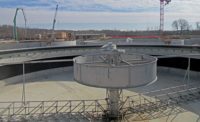A $427-million redesign and modernization of the world’s largest wastewater treatment plant is about a year away from converting the facility to larger primary settling tanks and a cleaner aerated grit facility. Those steps will also make it the greenest sewage and stormwater treatment plant in the area.
Sprawling across 413 acres in Cicero, Ill., just southwest of Chicago, the Stickney Water Reclamation Plant processes around 700 million gallons of storm and wastewater per day on average, but has the capacity to treat 1.2 billion gallons.
The Stickney plant serves 2.38 million people over 260 square miles, including most of Chicago and 43 suburban communities. It’s one of six wastewater treatment plants and 23 pumping stations in the Metropolitan Water Reclamation District of Greater Chicago (MWRDGC). Stickney is the largest wastewater treatment plant in the world.
“It probably always will be the largest because no one in their right mind would build one this big today,” says Peter Nielsen, senior project manager for the joint venture general contractor IHC Construction of Elgin, Ill., and F.H. Paschen S.N. of Chicago, which is nearing the end of the $224-million tank and aerated grit facility modernization project. “If, say, Columbus, Ohio, somehow grew to the population size and density of Chicago, you would not build this large of a facility. They’d just build several smaller ones all around the area. The land was available when it was built and the technology at the time was all put in one place.”
Stickney is actually two contiguous plants that went online more than 80 years ago. The western section came into service in 1927, while the southwest section followed six years later; both are named for the areas of Chicago they serve.
The problem that design engineer Greeley & Hansen had to tackle in the redesign was that the 1930s technology the expansive double plant depends on had long ago surpassed its useful life. Between 2003 and 2005, the engineer collaborated with Black & Veatch on a master plan, which is currently at Phase 2 of its implementation. The IHC/F.H. Paschen joint venture began Phase 2 construction in January 2015 and is targeting completion by April 2018.
To clean and reuse all that wastewater, Stickney previously used 108 Imhoff tanks in three batteries across the property. Named for the German engineer that invented them, Karl Imhoff, the tanks clarify sewage by simple settling and sedimentation, along with anaerobic digestion of the extracted sludge.
“There are no mechanical parts to an Imhoff, and it is a very slow process,” Nielsen says. “Modern tanks have rake arms and other mechanical features that can separate waste from water far more quickly.”
Waste That Produces its Own Fuel
Off-gassing of biological waste from the settling Imhoff batteries was also leading to increased greenhouse gas emissions and a nasty odor for residential neighbors, some of whom live directly across the street from the plant’s main entrance.
Converting to circular primary sedimentation tanks (PSTs) will accelerate wastewater treatment, with the added benefit of increasing by 15% the amount of digester gas available for the plant to use to fuel its operations. In 2004, when MWRDGC evaluated and approved Greeley & Hansen’s redesign, project officials estimated the savings on natural gas at $700,000 per year. Commodity prices of natural gas have fallen since then, but the district would still save from buying less of it.
Methane can replace natural gas and producing its own digester gas will help Stickney achieve its goal of being carbon neutral by 2023, in part by an estimated reduction of 536,185 tons per year of CO2 emissions saved through methane capture and reuse. The MWRDGC will not have to purchase as much natural gas and other fossil fuels because it can burn the methane that covered effluent troughs will capture while also containing the smell.
“The new PSTs will be much easier to take care of—maintenance and operations-wise—versus the Imhoff tanks,” says Ryan Christopher, Greeley & Hansen’s lead engineer for the current modernization phase. “Once this is up and running, it will be pushing 720 million gallons per day through the west side. That’s half of Stickney’s capable output, but most plants in the U.S. don’t even process a fraction of that … The new PSTs will give them much better control of their primary sludge, and they are expecting to increase their digester gas production once the PSTs are online.”
The Phase 2 Upgrade
A joint venture of Chicago-area construction companies George Sollitt/Sachi Group and Alworth Construction completed the $41.2-million first phase of the modernization in 2013 when crews demolished one battery of Imhoff tanks and settling tanks to make room for the nine 160-ft-dia, cast-in-place reinforced concrete PSTs.
In addition to constructing the tanks, during Phase 2 crews are building covered effluent troughs to contain plant odor, two operating galleries to monitor operations and four tunnel access pump stations. Additionally, workers are constructing a secondary switchgear building with two 13.2-KV/480-V step-down transformers and 480-V switchgear, the aerated grit facility for processing up to 720 million gallons per day of wastewater and a primary switchgear building housing 13.2-KV switchgear. Crews are also nearly finished restoring the facility’s existing west grit chamber and screen house.
“Our project will reorganize the flow of wastewater from the existing grit and fine screens building. The flow will come up from the pumping station through a screening building and then through our new aerated grit facility and then into these nine primary settling tanks,” Nielsen says. “When we’re online, these tanks will do everything that the Imhoff batteries did.”
The scope of the job approaches the scale of Stickney itself. Overall, contractors will place an estimated 72,000 cu yd of concrete before Stickney switches to the new process, scheduled for July 2018. The modernization’s third phase, estimated at $110 million and planned to start in 2019, will add nine more primary settling tanks.







---Urban-Mining-Industries-Pozzotive_ENRready.jpg?height=200&t=1663257031&width=200)
Post a comment to this article
Report Abusive Comment